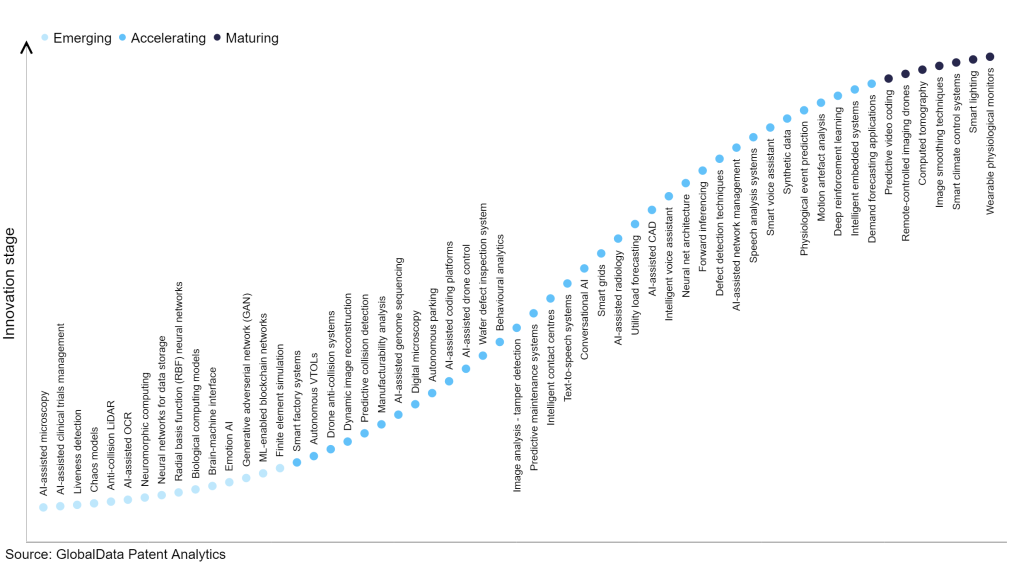The technology industry continues to be a hotbed of innovation, with activity driven by the growing advancements in artificial intelligence (AI) enabled algorithms that analyse large volumes of data from sensors and equipment to identify patterns and predict potential failures as well as the demand for efficient asset management and cost reduction in industries such as manufacturing, energy, and transportation. This has resulted in the growing importance of technologies such as machine learning, data analytics, and IoT integration, which enable real-time monitoring, predictive modelling, and intelligent decision-making. In the last three years alone, there have been over 3.6 million patents filed and granted in the technology industry, according to GlobalData’s report on Innovation in Artificial Intelligence: Predictive maintenance systems. Buy the report here.
However, not all innovations are equal and nor do they follow a constant upward trend. Instead, their evolution takes the form of an S-shaped curve that reflects their typical lifecycle from early emergence to accelerating adoption, before finally stabilising and reaching maturity.
Identifying where a particular innovation is on this journey, especially those that are in the emerging and accelerating stages, is essential for understanding their current level of adoption and the likely future trajectory and impact they will have.
300+ innovations will shape the technology industry
According to GlobalData’s Technology Foresights, which plots the S-curve for the technology industry using innovation intensity models built on over 2.5 million patents, there are 300+ innovation areas that will shape the future of the industry.
Within the emerging innovation stage, finite element simulation, machine learning (ML) enabled blockchain networks and generative adversarial networks (GAN), are disruptive technologies that are in the early stages of application and should be tracked closely. Demand forecasting applications, intelligent embedded systems, and deep reinforcement learning are some of the accelerating innovation areas, where adoption has been steadily increasing. Among maturing innovation areas are wearable physiological monitors and smart lighting, which are now well-established in the industry.
Innovation S-curve for artificial intelligence in the technology industry

Predictive maintenance systems is a key innovation area in artificial intelligence
Predictive maintenance systems utilise sensor data and other sources to anticipate maintenance or repair requirements for machines and equipment. By identifying potential issues in advance, these systems help prevent equipment breakdowns and minimise expensive repairs. Additionally, the data collected by predictive maintenance systems aids in making informed decisions regarding the timing and type of maintenance needed.
GlobalData’s analysis also uncovers the companies at the forefront of each innovation area and assesses the potential reach and impact of their patenting activity across different applications and geographies. According to GlobalData, there are 200+ companies, spanning technology vendors, established technology companies, and up-and-coming start-ups engaged in the development and application of predictive maintenance systems.
Key players in predictive maintenance systems – a disruptive innovation in the technology industry
‘Application diversity’ measures the number of different applications identified for each relevant patent and broadly splits companies into either ‘niche’ or ‘diversified’ innovators.
‘Geographic reach’ refers to the number of different countries each relevant patent is registered in and reflects the breadth of geographic application intended, ranging from ‘global’ to ‘local’.
Patent volumes related to predictive maintenance systems
Source: GlobalData Patent Analytics
General Electric is a leading patent filer in the field of predictive maintenance systems. One of the company’s patents describes a method and corresponding system for generating alerts during the production of a multi-layered part. The method involves determining sensor data values at the working tool positions for each layer and comparing them to reference data values to calculate a comparison measure. If the comparison measure falls outside a predefined range, an alert is sent, and an action is taken in the manufacturing process.
Other prominent patent filers in the space include Strong Force IoT Portfolio 2016 and Siemens.
By geographic reach, Fortum leads the pack, followed by GoerTek and Sandvik. In terms of application diversity, Engie holds the top position, followed by IHI and Geotab.
AI innovation in predictive maintenance systems has significant implications for industries reliant on machinery and equipment. By utilising AI-enabled algorithms and data analysis, these systems can predict when maintenance or repairs are needed, allowing for proactive actions to prevent equipment failures and minimise costly downtime. This technology enables companies to optimise maintenance schedules, reduce maintenance costs, and improve overall operational efficiency.
To further understand how artificial intelligence is disrupting the technology industry, access GlobalData’s latest thematic research report on Artificial Intelligence (AI) – Thematic Intelligence.
Data Insights
From

The gold standard of business intelligence.
Blending expert knowledge with cutting-edge technology, GlobalData’s unrivalled proprietary data will enable you to decode what’s happening in your market. You can make better informed decisions and gain a future-proof advantage over your competitors.







